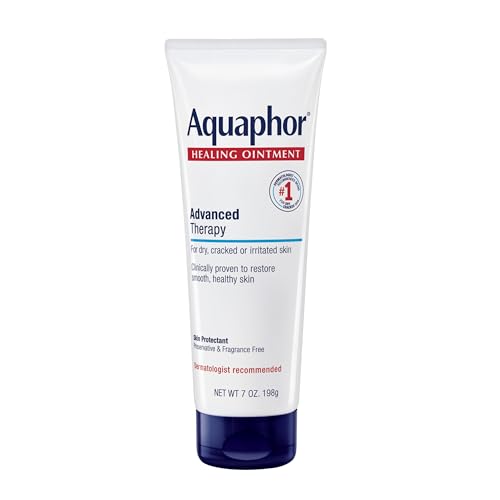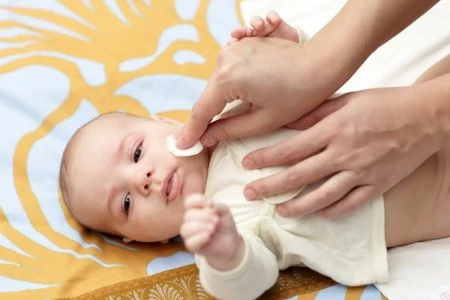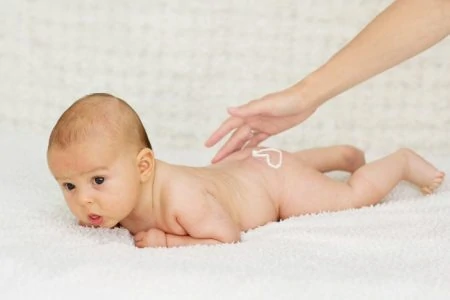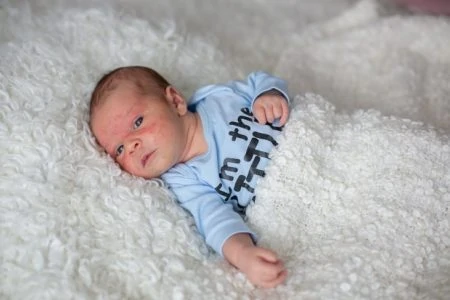Seeing your baby uncomfortable is heartbreaking. You want your little one to feel safe and cozy, but red, dry, or irritated skin can leave you feeling helpless.
While some babies eventually outgrow these sensitivities, others need a specific routine to keep flare-ups at bay. The goal is to manage the current symptoms while figuring out what triggers the reaction.
Take back control with these practical sensitive skin tips to ease your baby’s discomfort and put your mind at ease.
Key Takeaways
- Limit Bath Time: Bathe babies less frequently using lukewarm water, and apply moisturizer within three minutes of drying off.
- Check Ingredients: Prioritize “fragrance-free” over “unscented” products, and look for seals of acceptance from dermatological associations.
- Reduce Household Triggers: Use hypoallergenic laundry detergents, skip fabric softeners, and maintain a consistent indoor humidity level.
- Choose the Right Fabrics: Dress your baby in breathable fibers like cotton or bamboo to prevent heat rash and irritation.
Tips for Babies with Sensitive Skin
1. Less is More
When you first notice your child has sensitive skin, you might assume you need to do more. You might think frequent baths or thick layers of heavy-duty lotions will help. However, over-washing usually aggravates the situation (1).
Frequent exposure to water strips natural oils, which increases dryness and sensitivity (2). Stick to short baths using lukewarm water rather than hot water. Heat causes vasodilation, which leads to more itching and redness. This is vital if your baby shows signs of eczema.
I recommend bathing infants with eczema every two to three days, especially during colder winter months.
Directly after the bath, use the “three-minute rule.” Pat your baby dry gently (don’t rub) and apply a moisturizer within three minutes to trap water in the skin. Use a thick, dermatologically approved cream or ointment rather than a watery lotion for the best results (3).
2. Product Choice is Critical
You need to be highly selective about what touches your baby. It is not enough to just avoid harsh chemicals; you need to understand labeling.
Look for products labeled “fragrance-free” rather than “unscented.” “Unscented” products often contain masking chemicals to hide smells, which can still trigger reactions. Seek out products with the National Eczema Association Seal of Acceptance or similar dermatological approvals for dry skin or eczema.
Many sensitive skin conditions are related. A product that works for eczema will likely be gentle enough for general dryness or heat rash.
Baby aisles are full of sweet-smelling bottles designed to tempt parents. Do not be swayed by cute packaging. Trust your intuition; weed out products that smell like strong perfume, as they often do more harm than good.
The products that I typically recommend for my patients retain moisture longer on the skin, such as Eucerin, Cetaphil, and Aquaphor. I also like Cerave because, unlike other products on the market, it contains ceramides that mimic those that help retain moisture in the skin. The journal Dermatology Research Practice discusses infant skin care in further detail (4).
Editor's Note:
Dr. Leah Alexander, MD, FAAP3. The Importance of Household Products
Skin irritation often comes from the environment, not just baby products. Take a closer look at common household items that could be the culprit.
If you are not sure where to start, check these common triggers:
- Laundry: Use a liquid, fragrance-free, and dye-free laundry detergent. Powder detergents can sometimes leave a residue that irritates skin. Consider running a “double rinse” cycle on your baby’s clothes to ensure all soap is gone (5).
- Fabric Softeners: Skip the dryer sheets and liquid softeners. They coat fibers in chemicals that sit directly against the skin. If you need static reduction, try wool dryer balls.
- Air Quality: Air fresheners, diffusers, and scented candles can release volatile organic compounds (VOCs) that irritate sensitive skin and respiratory systems.
- Carpet Cleaning: Harsh commercial carpet cleaners stay in the fibers your baby crawls on. Baking soda is a natural alternative for odors, but vacuum thoroughly afterward, as even baking soda can irritate some skin types (6).
Carpet cleaning products can become an issue with infants when they begin to crawl. I have seen several patients with an irritating rash on the legs and knees, only to learn that the family recently cleaned their carpets.Editor's Note:
Dr. Leah Alexander, MD, FAAP
Do not be afraid to purge these items. Put them away until you have the skin issues under control. Once the skin heals, you can try reintroducing items one at a time to spot the reaction.
4. Fibers and Fabrics
Your baby spends all day and night wrapped in clothing or blankets. Synthetic fibers often trap heat and sweat, which creates a breeding ground for rashes.
Choose breathable cotton, bamboo, or natural fibers. These allow for air exchange and wick moisture away from the body.
Always wash new clothes before your baby wears them. New garments often have sizing chemicals (formaldehyde) used to keep them wrinkle-free in the store, which is a major irritant.
5. Diapers and Diaper Products
Diapers create a warm, moist environment that is tough on sensitive skin. Frequent diaper rashes are common, but manageable.
Rashes are not always caused by waste; sometimes the diaper material itself causes contact dermatitis (7).
Keep your little one dry with frequent changes. If you use standard diapers, try a brand labeled “chlorine-free” or “sensitive.”
Disposable wipes often contain alcohol or preservatives. Look for water-based wipes with minimal ingredients. Alternatively, use soft flannel reusable wipes with plain water.
If you suspect the chemicals in disposables are the issue, consider cloth diapers. They provide natural airflow that disposables cannot match.
Finally, air time is the best medicine. Let your baby play diaper-free on a waterproof mat for 10 to 15 minutes a day. Oxygen helps heal the skin faster than any cream.
6. Adventures with Food
There is often a connection between gut health and skin health. If you are breastfeeding, your diet might impact your baby’s skin.
Common triggers include dairy, soy, and gluten. If you notice a pattern of flare-ups after you eat certain foods, it is not a coincidence.
Clinically, I have seen facial rashes around the mouth or cheeks when older infants consume fresh berries or acidic foods such as tomatoes or oranges. This is due to the food’s contact with the skin, not an allergic reaction. Applying an emollient cream as a barrier can protect the skin from irritation while consuming these foods.
Editor's Note:
Dr. Leah Alexander, MD, FAAPIf you suspect a food allergy, talk to your pediatrician before starting an extreme elimination diet.
I found my youngest broke out in a rash across the face whenever I consumed dairy while nursing. I cut cheese and milk from my diet, and my baby’s skin cleared up within a week.
7. Monitor Temperature and Humidity
Environmental factors play a huge role in sensitive skin management. Dry air sucks moisture right out of the skin, while excessive heat leads to sweat, which is salty and irritating.
During winter, indoor heating makes the air very dry. Running a cool-mist humidifier in the nursery can help keep your baby’s skin hydrated.
Conversely, keep the house cool during the summer. Overheating is a primary trigger for eczema flare-ups. Dress your baby in layers so you can easily adjust their temperature.
Products to Soothe Sensitive Skin Issues
Finding the right products can feel like a science experiment. To save you some trial and error, here are three high-quality options that act as gentle, effective tools for managing sensitive skin.
1. Garden of Life Organic Cold Pressed Extra Virgin Coconut Oil

Coconut oil is a versatile powerhouse. It acts as a natural moisturizer and has antimicrobial properties.
It is a go-to for peeling lips, sore bottoms, or cradle cap. A little coconut oil smoothed on after a tepid bath can lock in moisture without the stinging sensation some lotions cause.
Because it has a high melting point, you can rub it between your hands to liquefy it before massaging it into your baby. This Garden of Life oil is non-GMO and unrefined, meaning it retains all its natural benefits.
Note: While rare, some babies can be allergic to coconut. Always do a small patch test on their leg before applying it all over.
In my patients with moderate to severe eczema, coconut oil seems to work the best, even more so than other products that are marketed for this purpose.
Editor's Note:
Dr. Leah Alexander, MD, FAAP2. Burt’s Bees Calming Shampoo and Body Wash

If you miss the “new baby smell” but cannot use standard products, this is a great compromise. It uses natural lavender and vanilla for a scent that is soothing but not overpowering.
I appreciate that this wash is tear-free and plant-based. It cleanses without stripping the skin of natural oils, which is crucial for preventing post-bath itchiness.
It is pediatrician-tested, hypoallergenic, and free of phthalates, parabens, and petrolatum.
Pairing this with a solid bedtime routine helps signal to your baby that it is time to sleep (8). Just remember to monitor your baby’s skin; even natural fragrances like lavender can occasionally irritate highly reactive skin.
3. Aquaphor Advanced Therapy Healing Ointment

Aquaphor is a “barrier” product. Unlike a lotion that sinks in quickly, this ointment sits on top of the skin to protect it from outside irritants (like drool or urine) while allowing the skin underneath to heal.
It is fantastic for “drool rash” on the chin or stubborn diaper rashes.
Because it is petroleum-based, it can repel water, making it excellent for preventing diaper rash but difficult to wash out of cloth diapers. If you use cloth, use a liner or switch to disposables while using this product.
It can feel greasy, so I recommend applying it right before bed or immediately after a bath to lock in hydration.











